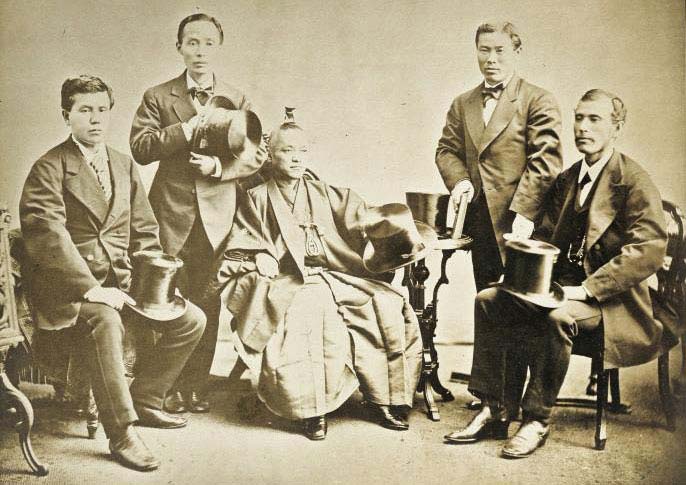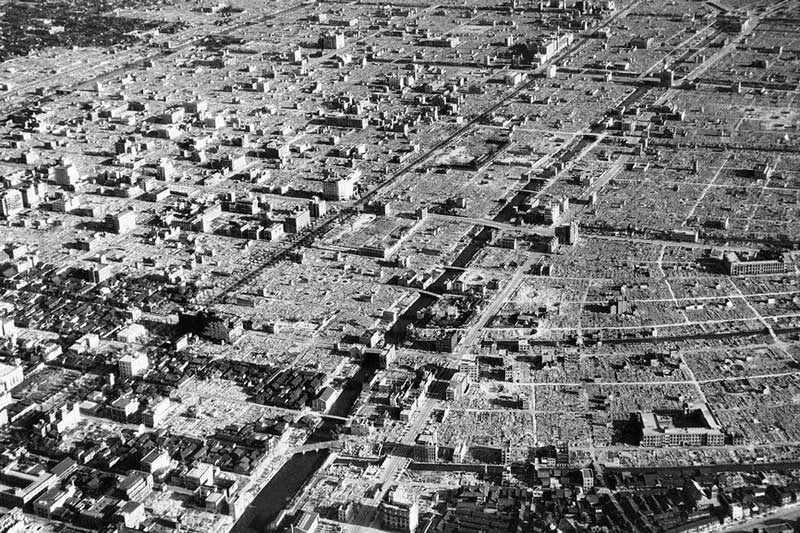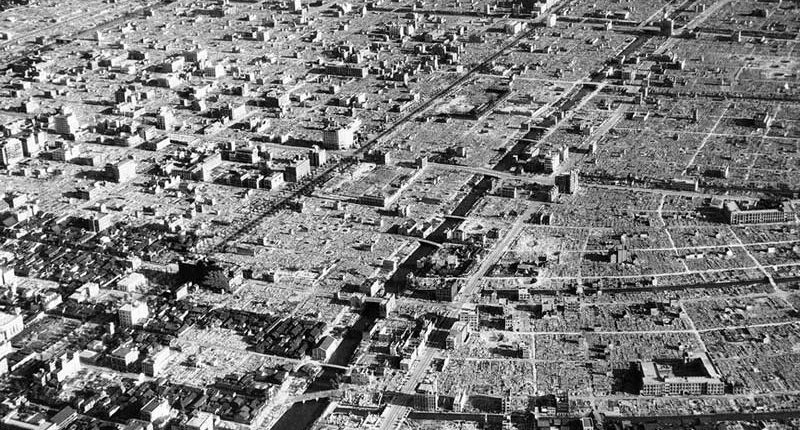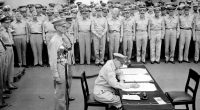The relative ease with which power shifted back to the emperor stood in contrast to the huge task of nationalization which lay ahead. While Tokugawa rule had unified the country, governance was still semi-feudal in nature and the social structure remained based on the shinokosho hierarchy.
The emperor moved from Kyoto to Edo in 1868 and the city became the official capital (and subsequently renamed Tokyo, “Eastern City”). The task of day-to-day governance, however, was carried out by a select group of advisors, men of standing from the southern clans of Satsuma and Choshu who had played a significant role in the Meiji Restoration. These men, called genro, would effectively run the show in the background for most of the Meiji era. Once again in Japanese history the south—partially regarded today as the backwater of the country—played an inordinate role in the country’s political and economic development.
One of the first acts of the new polity was to implement the Charter Oath, considered to be the country’s first modern constitution. It consisted of five progressive, basic tenets:
- Deliberative assemblies shall be widely established and all matters decided by open discussion.
- All classes, high and low, shall be united in vigorously carrying out the administration of affairs of state.
- The common people, no less than the civil and military officials, shall all be allowed to pursue their own calling so that there may be no discontent.
- Evil customs of the past shall be broken off and everything based upon the just laws of Nature.
- Knowledge shall be sought throughout the world so as to strengthen the foundation of imperial rule.
The fifth point demands particular attention as it paved the way for Japan to embrace the superior technological and industrial knowledge held by the Western powers. It is ironic that although the “expel the barbarians, revere the emperor” camp had played a significant role in bringing about the end of Tokugawa rule (a period known as bakumatsu), the constitution clearly ended the country’s isolationist policy.
Japan wasted no time in playing catch-up. Just about all aspects of governance and state were reformed. The military was modeled on the French system; the navy on the British fleet. In addition, a multitude of highly-paid foreign advisors were brought to Japan to instruct on subjects ranging from agriculture and medicine to engineering and education. Mining, steel production, shipbuilding, cotton spinning, textiles, silk—all witnessed rapid expansion during the Meiji era. Annual coal production, for instance, stood at 210,000 tons in 1874, but within ten years would reach 4 million tons and continue to more than double each decade such that by the end of World War I it would stand at over 30 million tons. Women played a key role in the silk and textile factories, working long hours and often in extremely poor conditions. By the late 19th century Japanese silk accounted for over 25% of the world’s market. Model factories were also established to encourage entrepreneurial Japanese to follow suit and set up similar businesses throughout the country.
Progress was not only industrial, but social, as well. First, the shinokosho hierarchy was disassembled and samurai, farmer, artisan, and merchant alike given the status of “commoner”. Even the hinin (literally, “non-human”, the word was used to refer to those in undesirable professions such as undertaking), regarded as so lowly in the social structure the shinokosho hierarchy didn’t even account for them, were recognized as commoners. For the samurai, the final nail in their coffin was nationwide conscription in 1873, which meant that the right to bear arms was no longer theirs alone. The Land Tax Reform of the same year saw the domains of the daimyo replaced with prefectures and the right to private ownership put into law.
Realizing that it could not continue to rely on foreign advisers for sustained development, Japan implemented a program of sending statesmen and promising (or privileged) students abroad to study in the hope that they would come back and transfer their knowledge to others. The most famous of these is the Iwakura Mission between 1871-1873 which saw leading statesmen, scholars, and students travel to the United States, the United Kingdom, as well as a host of mainland European countries, before making their way back to Japan via Egypt, Ceylon, and Singapore, among other places.

School education was made compulsory and by the turn of the century attendance rates surpassed those of all the Western nations. The educated workforce that this created would serve Japan well throughout the 20th century.
Nevertheless, the philosophical question around Japan’s standing with the Western powers remained, and by the late 19th century there was considerable dialogue around the need for Japan’s own empire—a “colonize or be colonized” mindset was slowly being ingrained in the minds of the ruling elite.
Despite its grievances at being forced to sign the Harris Treaty, Japan had no compunction about using gunboat diplomacy to strong-arm Korea into signing a trade agreement on similar terms. The Japan-Korea Treaty of 1876 really marks the starting point of Japan’s imperial ambitions. It also served to undermine Korea’s status as China’s tributary by re-affirming the country as an independent state with sovereign rights. One failed coup and a broken Sino-Japanese agreement later and Japan and China were at war, one which the Japanese with their newly-trained army won swiftly, occupying Korea and much of Manchuria before the Chinese sued for peace in 1895.
Japanese hopes for official rights to land and indemnity, however, were thwarted by Russia, Germany, and France in what is known as the Triple Intervention. Russia also had interests in the Korean peninsula and this led to war again in 1904. This time it was Japan’s navy which proved decisive, making a surprise attack on Russia’s ships at Port Arthur (Dalian, China) before destroying the rest of the Russian fleet in the Tsushima Straits (between southern Japan and Korea). It was the first time a Western power had been defeated by an Asian nation in modern history and it sent shock waves through the international community. The two military victories were also significant because, along with swift economic development back home, they gave the Japanese a sense that they had developed enough socially, economically, and technologically to be treated as equals by the Western powers. They were to be disappointed.
Japan joined World War I at the request of Great Britain in August 1914, occupying German territories in China (Shanghai and Tsingtao among them). Its role earned it a seat on the Council of the League of Nations (something, incidentally, it does not hold at the United Nations Security Council) and, spurred on by its new status as a global power, Japan pushed for the one thing that had eluded it since the ink was setting on the Harris Treaty: equality. To this end, the country proposed the following wording for inclusion in the Treaty of Versailles.
The equality of nations being a basic principle of the League of Nations, the High Contracting Parties agree to accord as soon as possible to all alien nationals of states, members of the League, equal and just treatment in every respect making no distinction, either in law or in fact, on account of their race or nationality.
But the passage proved problematic for the colonial powers (what, for instance, would the implications be for Great Britain and India?) and, despite the majority being in favor, it was rejected by the U.S. and Great Britain. That was the first set back. Then came the 1921 Washington Naval Treaty which set the ratio of construction for battleships between the United States, Great Britain, and Japan at 5:5:3. This was followed by the U.S. Immigration Act of 1924—a federal law which was ostensibly put in place to limit the number of immigrants, but had the practical effect of barring Japanese from entering the country.
Japan’s sense of affront was not without basis. These rebuffs all served to fuel ultra-nationalist movements in Japan and, more broadly, a growing resentment of the Western powers among the populace. It withdrew from the League of Nations in 1933.
The 1930s in Japan witnessed a steep rise in political turmoil and assassinations, and an increasing number of right-wing members with strong links to the military came into positions of influence. In particular, the Kwantung Army—a section of the Imperial Japanese Army tasked with control of occupied Manchuria—began to exercise a disconcerting degree of autonomy from the polity back in Tokyo.
First there was the Manchurian Incident in 1931, an explosion on a section of railway line owned by Japan’s South Manchuria Railway staged by members of the Japanese military to provide a pretext for the annexation of northeast China. Then there was the Marco Polo Bridge Incident in 1937, an exchange of fire between Japanese and Chinese troops. The facts are disputed but that the incident escalated into the second Sino-Japanese War is not. Japanese forces soon made advances south into mainland China, something for which members of the military elite, at least, had been pushing.
Japanese aggression in China—especially once news of atrocities committed in Nanking spread—brought condemnation from the international community. In August 1941, following a series of increasingly harsh sanctions, the United States froze Japanese assets and placed a complete oil embargo on the country (significant because about 80% of Japan’s oil was imported from the U.S.). The response of Japan’s prime minister, Tojo Hideki, was to launch a surprise attack on the U.S. naval base at Pearl Harbor on the morning of 7 December, 1941, with the aim of eliminating the possibility of U.S. interference in Japan’s imperial ambitions in Asia. The U.S. declared war on Japan the following day.
The threat of the U.S. from the east seemingly dealt with, and the other Western powers bogged down in Europe, Japan had a free hand in Asia. Within months Hong Kong, Manila, and Singapore had fallen to the Japanese Imperial Army as it continued to push its way throughout the region.
By mid-1942, however, the tables were turning. Japan’s navy suffered the loss of four aircraft carriers and one heavy cruiser at the battle of Midway, and with the capture of Saipan by U.S. forces in 1944 the mainland was within the range of the U.S. air force’s B-29 bombers. The air raids of Tokyo that ensued were among the most destructive in world history (Operation Meetinghouse conducted over two days in February, 1945, saw 300 B-29s drop almost 2,000 tons of napalm on the city, killing more than 100,000 people and leaving another one million homeless). Brutal fighting on Iwo Jima and Okinawa followed as allied forces island-hopped towards Honshu.

Then, on the morning of 6 August, 1945, the Enola Gay, a B-29 Superfortress, dropped “Little Boy” on Hiroshima. The atomic bomb exploded 2,000 feet above the ground, killing thousands instantly and leaving many thousands more with horrific burns. Three days later another atomic bomb was dropped on Nagasaki with similar devastating effects (Kokura in northern Kyushu had been the original target but cloud and smoke cover over the town meant that the flight crew changed course to Nagasaki, the reserve target, after three fly overs).
Following a failed coup d’etat by some members of the government and military, a recording of a speech by Emperor Hirohito—in classical language difficult to understand for many Japanese—was broadcast to the populace on the noon of 15 August. He explained that the government would unconditionally surrender and beseeched them to “endure the unendurable and suffer what is not sufferable”. It was the first time the Japanese people had heard his voice.
- Next: The Post-War Era & Modern Japan
- Previous: The Edo Period



